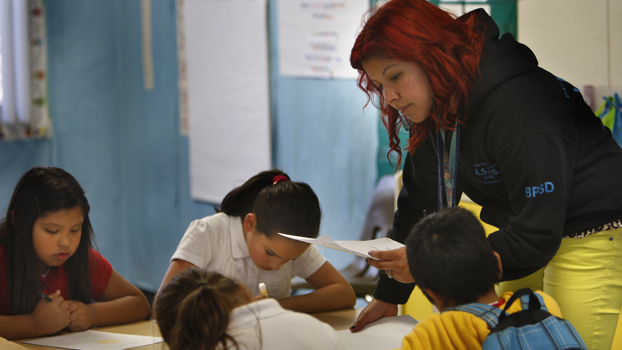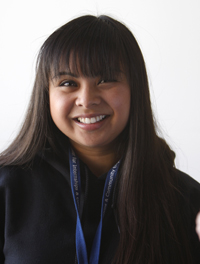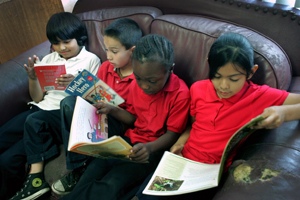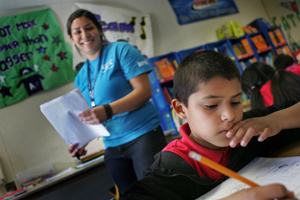 Caption: CSUF junior Kathy Padilla, a liberal studies major, helps tutor children at Carl E. Gilbert Elementary School as part of the After School Education and Safety Program operated by Cal State Fullerton in the Buena Park School District. Photo: Karen Tapia Download Photo
Caption: CSUF junior Kathy Padilla, a liberal studies major, helps tutor children at Carl E. Gilbert Elementary School as part of the After School Education and Safety Program operated by Cal State Fullerton in the Buena Park School District. Photo: Karen Tapia Download Photo
A Two-Way Educational Experience
After School Program Provides Benefits for Both College and Younger Students
April 26, 2012
A collaborative effort between Cal State Fullerton’s Center for Internships and Community Engagement and the Buena Park School District is providing valuable lessons for all participants — both providers and recipients of services.
The After School Education and Safety Program reaches nearly 600 second- to eighth-grade youth in Buena Park. They receive individualized attention to assist them with reading comprehension and homework assignments, and they take part in enrichment activities, such as sports and clubs.
A cadre of students from Cal State Fullerton, as well as those from community colleges and other state universities, provide the services.
Funding for the 5-year-old program has been renewed for the current academic year with a $432,879 school district contract. The Buena Park School District receives funding through Proposition 49, approved in 2002.
“CSUF student participants use the experience to fulfill academic internships, service-learning requirements or gain experience working with young students. Even some campus organizations participate,” said Dawn Macy, associate director of the university’s Center for Internships and Community Engagement.
Three lead students oversee two schools each. Working with them are assistant leads at each of the schools, as well as instructors.
“All of our college students receive extensive and ongoing training to help them work with the students under their direction and deliver curriculum to classrooms of 20 youth. These are certainly not easy tasks when working with children who have already spent a full day in school,” she said. “Our college students participate in community engagement in all levels of programming and gain valuable insight into their own areas of interests, strengths and professional development.”
The participating Buena Park schools are: Gordon H. Beatty, Arthur F. Corey, Carl E. Gilbert, Mabel L. Pendleton and James A. Whitaker — all K-6 schools, plus Buena Park Junior High.
“The ASES Program is great and extremely beneficial to the students served,” said Jillian Madrigal, a CSUF senior majoring in sociology who serves as a program coordinator for both Gilbert and Whitaker schools. “Not only are the kids in a safe place during the time most noted for juvenile crime, but they have extended learning opportunities they may not be able to receive at home.
“The kids are genuinely cared for by each staff member at ASES and it shows,” the Pico Rivera resident added. “The confidence instilled in the kids throughout the year in ASES is displayed when many of our kids are bumped up from ‘below basic’ or ‘far below basic’ to ‘proficient’ or even just brought up to ‘basic’ on the state examination,” she noted. “I believe ASES is a great place for students to be after school. Although it is an educational, reading intervention program, inadvertently, the kids’ character also is built.”
Raquel Campos, coordinator for Pendleton and Beatty schools, agreed. “The program is a great support system not only for the students, but also the schools and families in the community. ASES is a place where students can come and receive homework assistance, help in any academic subject they may be struggling with during the day, instruction and enrichment activities. ASES is a great, safe place for students to learn how to become team players in many different areas.”
 Caption: Jennifer Rodil Download Photo
Caption: Jennifer Rodil Download Photo
“The students are very responsive to myself and the other staff,” said Jennifer Rodil, one of the program’s instructors and a CSUF senior majoring in child and adolescent development. “This is because the ASES program provides a diverse line of training — from classroom management to behavior case scenarios, which are all very effective in and out of the classroom. Like any classroom educator, there are ups and downs between student behavior dynamics, but that's a part of the learning process. Because the majority of our instructors are students, as well, our students feel a great sense of relatedness to our instructors, but still manage to respect them on an educator-student level.”
“Through each aspect of our program, the kids we serve learn core values from staff through a mutual respect and understanding,” Madrigal added. “Yes, education is important, but to know and have that feeling that we have helped shaped these children into becoming productive and responsible people, who come back years later to visit and volunteer their time to the program that once served them, is simply irreplaceable. For me, this is the part that is most meaningful in working with youth.”
“The most meaningful part about my job is seeing students succeed when they had felt they couldn’t accomplish it,” said Campos, a Montebello resident, who graduated last year with a bachelor’s degree in English. “The success and safety of our students is what's most important to me, but the ASES staff and supervisors have helped me with my professional development. Every school year I feel the growth in my supervision, communication and student involvement.”
“Being an instructor in the program taught me the foundation of what it takes to be a future educator,” said Rodil, who lives in Diamond Bar. “I originally went into the program with the intent of gaining experience to become a future elementary schoolteacher and found that the dynamics in after school programming fit extremely well for my future aspirations.”
Though she no longer plans to become a schoolteacher, she said, “I do plan on implementing the educational philosophies that I learned through this experience in my future career of becoming a student affairs professional.”
“It’s a good partnership,” said Chris Perez, program director. “Not only are we able to provide day-to-day assistance, we are creating ties and relationships that encourage the youngsters under our charge to consider the opportunities that an education can bring, including college.”
More information about the program is available online.


